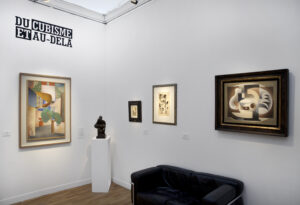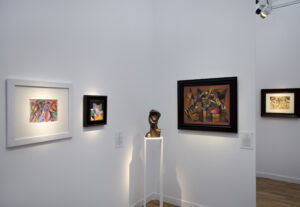FIAC 2019
AROUND THE GOLDEN SECTION
For the 2019 edition of the FIAC, the Le Minotaure gallery is offering an exhibition around the Golden Section, this branch of Cubism freed from the solutions of the “Kahnweiler stable” often limiting the movement to the sole names of Braque and Picasso .
Following in the footsteps of the organizers of the three legendary Salons of the Section d’Or – taking place in 1912, 1920 and 1925 – we would like to present the diversity of approaches that artists such as the Delaunay couple, Frantisek Kupka, Amédée Ozenfant, Louis Marcoussis, Serge Férat, Léopold Survage or Henri Valensi or Georges Valmier, could have had cubism in the 1910s and 1920s. It was within the Salon – and within the framework of members’ meetings at the Duchamp brothers in Puteaux – that these artists were able to discuss and exhibit their works, often rejected by official salons; it is there that Marcel Duchamp presented his Nude Descending the Staircase refused to the Independents; that Kahnweiler discovered Juan Gris; and that the Delaunays presented their compositions later baptized by Guillaume Apollinaire as orphiques.
A set of works by Serge Férat (part of the steering committee of the 1920 Section, also being its treasurer) and Léopold Survage (a leading figure in the 2nd Section) will represent the Russian artists of the Golden Section as well as the the adventure of Soirées de Paris, an avant-garde literary magazine founded by Apollinaire and financed by the fortune of Baroness d’Oettingen (alias François Angiboult, present as a painter at the Section’s exhibitions). We will exhibit, among others, one of Survage’s “Colorful Rhythms” which testifies to the interest that many painters in the group, such as Kupka or Valensi, had for the links between painting and music.
Valensi played an important role in the Golden Section, as an organizer and collaborator, from its first edition. His paintings demonstrate the original evolution of Cubism towards Orphic abstraction and the desire of artists linked to the Salon to add movement, color and music to the more orthodox solutions of analytical Cubism.
To evoke other cubists present at the Section d’Or and on the Parisian (international) scene of the period, we will present paintings by the Russian Baranoff-Rossiné, the Hungarian Josef Csaky), the Polish Louis Marcoussis, Fernand Léger, or still by Amédée Ozenfant, the father of purism, as well as a series of gouaches by Frantisek Kupka.



